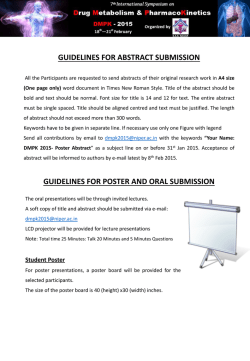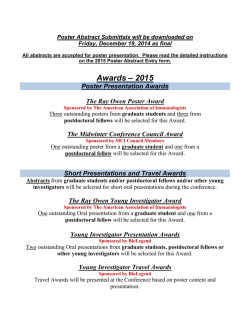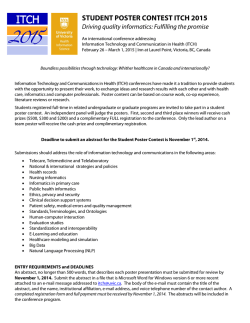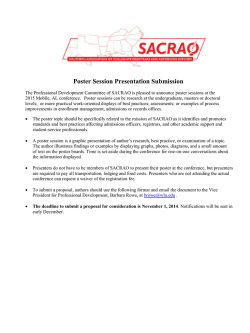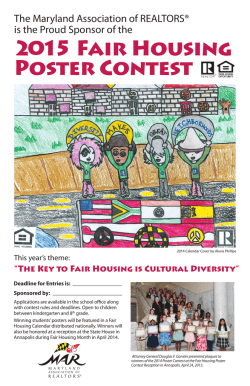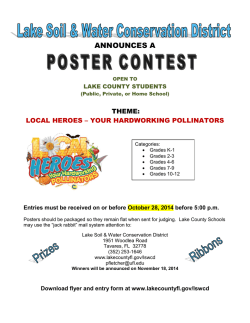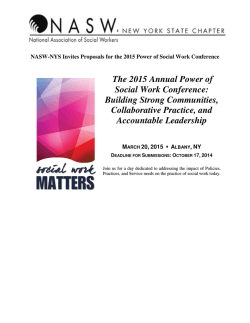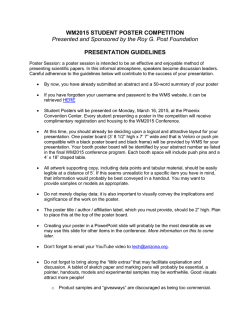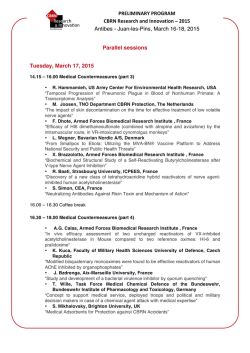
Announcing Poster Competition for the 2015 Toshio Narahashi
November 2014 DEAR NTSS MEMBERS: In this beautiful fall season, the NTSS Executive Committee would like to provide updates on key activities of our specialty section from the past several months. We hope you were able to submit an abstract and looking forward to seeing you at the upcoming 2015 SOT meeting in beautiful San Diego, California. Our NTSS group is comprised of members from all walks of neurotoxicology including academic, medical, industry, government and regulatory professionals. To highlight this strength, the NTSS executive committee has decided to include a focus article from NTSS members working in one professional avenue for the benefit of all. We have named this new section of the newsletter the “Neurotoxicology Professional Crossroads”. This fall we are delighted to highlight an essay by Drs. Crofton and Mundy from the United States Environmental Protection Agency. Following this essay we provide an update of recent and future NTSS activities. Renew your membership to NTSS!!! Your membership provides the financial support to keep our specialty section running. The NTSS seeks to promote neurotoxicology as vibrant specialty of toxicology. For example, the executive committee actively seeks to enhance and promote neurotoxicology themed session at the annual meeting. As detailed below, for the second year in a row we have achieved a record number of accepted session proposals sponsored by NTSS for the SOT2015 annual meeting. NTSS also offers each of you a place to meet up with your colleagues at our annual SOT reception. We support the growth of our field now with the endowed Toshio Narahashi Fellowship Award program – as this endowment grows we hope to provide even more opportunities to support the next generation of neurotoxicologists. NTSS also has provided an online home and social connections via our facebook and website that includes recent announcements of interest to our field. Your membership continues to be the foundation of our section, and I encourage you to renew your membership and speak to your colleagues in the field who are not members to join us. Announcing Poster Competition for the 2015 Toshio Narahashi Neurotoxicology Fellowship Process: To participate in the 2015 poster competition, you will need to submit an extended abstract by February 23, 2015. The extended abstract will consist of the abstract originally submitted to SOT, 2-4 sentences describing the impact of the research, up to one page of key figures or data, and a 3-5 sentence conclusion (total of 3 pages). The extended abstracts will be reviewed by a committee prior to the meeting and will comprise 50% of the score. The remaining portion of the score will be based on the faceto-face interviews at your posters on Monday late afternoon. At this point we anticipate approximately 3 judges will evaluate each poster. More detailed information will be posted on the NTSS website: http://www. toxicology.org/isot/ss/NTSS/awards.asp. Eligibility requirements for the NTSS poster competition: (1) Graduate students and postdoctoral research fellows/associates must be in attendance at the 2015 annual meeting; (2) trainees must meet SOT criteria for classification as a graduate student or postdoctoral fellow at the time of the annual meeting; (3) graduate students and postdocs MUST be members of NTSS or show evidence of application for membership. Graduate students or postdocs giving platform presentations at the annual meeting are also eligible if they prepare a poster summarizing their talk. Advisors or mentors who are not members are strongly encouraged to join NTSS. Submission requirements: (1) An extended abstract as defined above (3 pages); and (2) a letter of support from the graduate student’s advisor or postdoctoral mentor outlining the independence and role of the candidate in the research must be submitted to Anumantha Kanthasamy ([email protected]), Chair of the NTSS Student and Postdoctoral Awards Committee by February 25, 2015. Participants will also be required to send a PDF of their complete poster to Dr. Kanthasamy by March 16, 2015 to facilitate the judging (this presubmission of the poster need not be the final version presented at the 2015 Annual Meeting). In addition to recognition plaques for each winner, monetary prizes will be awarded for first, second and third place. Winners will be announced at the annual NTSS Business Meeting in San Diego. NTSS members interested in judging either extended abstracts and/or posters should contact Anumantha Kanthasamy ([email protected]). 1 NEUROTOXICOLOGY PROFESSIONAL CROSSROADS – NEUROTOX IN GOVERNMENT Developmental Neurotoxicity Testing: Progress and Challenges Contributed by: Kevin Crofton and William Mundy Traditional animal studies for developmental neurotoxicity based on U.S. EPA or OECD guidelines are time and resource intensive, and ongoing efforts to provide alternative methods have focused on two primary issues: (i) the need to screen tens of thousands of chemicals for potential bioactivity, and (ii) the need to develop and use in vitro and in silico models based on human biology. Significant advances in the field of in vitro testing methods for DNT were discussed at the Fourth International Conference on Alternatives for Developmental Neurotoxicity (DNT) Testing (http://caat.jhsph.edu/programs/workshops/ DNT4/index.html). Research efforts have led to the development and characterization of a variety of cell-based systems, as well as characterization of alternative model organisms. Cellular models that assess a variety of DNT endpoints include primary neuronal cells from rodents, human and rodent tumor-derived neuronal cell lines, and stem/ progenitor cell-based neural cells from humans and rodents. Alternative species such as C. elegans and zebrafish have also been used to study the impact of chemicals on the developing nervous system. More recently, 3D models have been established that allow chemical testing in systems that better recapitulate the normal physiology of neurodevelopmental processes. Progress has also been made using microelectrode arrays and ‘brain on a chip” technologies to study neuronal function in vitro. These methods all allow for higher throughput testing of chemicals on critical neurodevelopmental processes. inspired engineering makes use of new microfluidic organs-on-chips methods that more accurately simulate neurodevelopment at the tissue- and organ-level (http://wyss.harvard. edu/). The ultimate goal is to develop a set of models and assays in a test battery that covers pathways and processes of brain development as comprehensively as possible. Together these new tools demonstrate significant progress in developing 21st century approaches for DNT testing. However, development of the nervous system involves complex spatial and dynamic interactions between cell types and developmental processes including differentiation of embryonic stem cells, cell migration, neural stem cell proliferation, differentiation into neurons and glial cells, neurite outgrowth, synaptogenesis and network formation. Due to this complexity it is unlikely that any one assay will correctly identify DNT potential for all chemicals. Thus, several approaches are currently being pursued. One approach is based on the development of a battery of assays using multiple cell types, with each assessing an individual neurodevelopmental process. More recent advances in biologically A second issue in the development and use of in vitro data for regulatory purposes is the lack of well-described and codified adverse outcome pathways (AOPs) for developmental neurotoxicity. A recent ISNET workshop (International STakeholder NETwork, Zurich, January 2014) focused on how AOPs foster regulatory acceptance of data from alternative methods for DNT (http://www.altex.ch/All-issues/Issue.50. html?iid=149&aid=8). One advantage of AOPs is that they highlight key biological targets, for which in vitro assays can be developed, that are linked to adverse outcomes. To date, only a limited number of peer-reviewed AOPs are available for DNT. A recent workshop (EU Reference Laboratory for Alternatives to Animal Testing, March 2013, Ispra, Italy) highlighted the need for the development A number of challenges remain concerning application and predictability of in vitro assays. First is the need to implement test methods and collect data that allows judgement of their utility in screening for DNT. The state of the science for other areas of toxicology, such as developmental, reproductive and endocrine toxicity as well as carcinogenesis has made immense progress, including the development of in vitro testing databases for hundreds of assays and thousands of chemicals in the ToxCast and Tox21 programs (http://ntp.niehs.nih.gov/results/hts/index.html). This has fostered development of computational models predicative of in vivo adverse outcomes. To date, a limited number of in vitro DNT assays have tested small sets of chemicals (2075 chemicals). This lack of adequate data for large numbers of chemicals from in vitro DNT assays has severely hampered development of computational models. Alternative DNT assays must be used to screen larger chemical libraries (e.g., Tox21/ToxCast). Chemical libraries should also contain chemicals known or suspected of causing DNT. Lists of such chemicals have been proposed. of more AOPs for neurotoxic and developmental neurotoxic outcomes, and provides a number of putative AOPs for further development. To foster AOP development a new crowd-sourcing Wiki-based platform is available for developing and sharing AOPs. Information about the AOP Wiki and a User Handbook is available at: https://aopkb.org/. The lack of AOPs hampers development of correlative or causative links from in vitro assays that target upstream key events to adverse outcomes. These linkages are critical in building confidence for use in regulatory decisions. Creation of AOPs for DNT must take into account the temporal and dose dynamics critical for neurological development. This is needed to ensure that in vitro and alternative species models encompass all the processes of neurodevelopment necessary for proper brain development. This type of approach will also assist in the targeted generation of missing molecular, cellular, tissue and organismal level data using in vitro and in vivo methods to develop validated AOPs. The EPA has recently awarded four STAR grants to support development of AOPs for DNT http://cfpub.epa.gov/ncer_abstracts/index.cfm/ fuseaction/recipients.display/rfa_id/562 The incredibly rapid advances in basic neurobiology, new testing technologies and computational modeling provide a variety of new tools for developmental neurotoxicologists. The time is ripe to employ these tools to better characterize the hazards of the thousands of chemicals that currently lack hazard data. Not only will such data help to define or reduce uncertainties in risk assessments, but also provide the data and models critically needed for development of the greener chemistry solutions required for a more sustainable future. Update on Toshio Narahashi Neurotoxicology Fellowship Endowment Fund There was an overwhelming response of the Neurotoxicology Specialty Section members in contributing to our Endowment Fund: the Toshio Narahashi Neurotoxicology Fellowship Award. One year ago we had a balance of just over $13,000, and were in danger of not meeting the goal of $25,000 required by SOT to establish the endowment fund. Since that time there was flood of contributions, large and small, from individuals, groups and corporate donors. As of June 30, 2014, the most recent data available, the Fund had a balance of $47,458. We far exceeded our goal, and the Narahashi fund has now been established as a Permanently Restricted Net Asset Fund. When a fund achieves the permanent designation, it will be maintained by SOT in perpetuity for the donor-designated purposes. Thank you sincerely to all who contributed! Incidentally, since the time the Narahashi fund achieved permanent status, SOT raised the threshold to $50,000, but we were “grandfathered in” and will retain the permanent status. Note that we are just short of the $50,000 threshold now required of newly established endowment funds. Please consider making another tax-deductible donation to the Narahashi Fund this year, or if you have not yet contributed, please join your many colleagues in supporting this worthy cause. For each dollar of donation, the Society will match the contribution dollar-for-dollar up to $400,000, meaning that your contribution dollars will go even farther. Increasing the size of the endowment fund will mean that the NTSS can better support student stipends and awards. Few things we do will have such an impact on so many young scientists early in their careers, and will continue to do so in perpetuity. To make a donation, please click on http://www. toxicology.org/ai/csot/contribute.asp Be sure to select Toshio Narahashi Neurotoxicology Fellowship Award under named funds. Recommended donation levels: PARACELSUS: $500-more; GOLD: $250-$499; SILVER: $100-249; BRONZE: $40-$99. A Record Number of NTSS Sponsored Scientific Programs at the 2015 Annual SOT Meeting On the heals of our record breaking 8 NTSS sponsored sessions for SOT 2014, NTSS was successful in sponsoring 9 sessions for SOT 2015. Furthermore, the number of session proposals that NTSS was asked to sponsor also hit a new high. The NTSS session review team of Drs. Anumantha Kanthasamy (PastNTSS President), Aaron Bowman (NTSS President), William Boyes (NTSS Vice-President) and Abby Li (Vice-president Elect) worked hard and provided feedback on all initial proposals submitted to NTSS for sponsorship. Final proposals were evaluated and ranked. We encourage you to start planning now for potential SOT 2016 proposals. If you have session ideas you want to run by the review committee please feel free to contact any member of the session review team from 2015. Our goal is to maximize the success of every proposal. Of the 17 NTSS-sponsored proposals submitted for consideration by the 2015 SOT program committee we had 9 accepted, including 3 symposia, 4 workshops, 1 roundtable and 1 continuing education course – listed below: Congratulations to the Chairs of these successful proposals and looking forward to great talks at the annual meeting! SYMPOSIUM 01: Adult Neurogenesis in Chemical-Induced Neurotoxicities: A New Frontier in Toxicological Mechanistic Investigations, Biomarker Research, and Therapeutic Targeting. Chairs: Zheng (Purdue) and Bowman (Vanderbilt) SYMPOSIUM 14: New Developments in the Management of Nerve Agent Poisoning. Chairs: Vale (University of Birmingham) and Thiermann (Bundeswehr Institute of Pharmacology and Toxicology) SYMPOSIUM 15: Nrf2 Signaling Pathways in Model Systems: A Master Regulator of Neurotoxicity and a Potential Therapeutic Target. Chairs: Nass (Indiana University) and Johnson (University of Wisconsin) WORKSHOP 06: Deciphering Clinical and Experimental Retinal Toxicology: An Eye on the Present and Future. Chairs: Chow (Allergan) and Fox (University of Houston) WORKSHOP 08: Environmental Exposures and Alzheimer’s Disease: Epidemiology, Mechanisms, and Future Strategies. Chairs: Richardson (Rutgers University) and Kanthasamy (Iowa State University) WORKSHOP 18: Microphysiological Models of the Developing Nervous System: Biologically-Driven Assembly Inspired by Embryology and Translated to Human Developmental Toxicology. Chairs: Knudsen (US EPA) and Slikker (US FDA) WORKSHOP 21: Regulatory Neurodevelopmental Testing: New Guiding Principles for Harmonization of Data Collection and Analysis. Chairs: Li (Exponent) and Bowers (Health Canada & Carleton University) ROUNDTABLE 01: Addressing Potential Age-Related Sensitivity to Neurotoxicity of Pyrethroids. Chairs: Osimitz (Science Strategies, LLC) and Lowit (US EPA) CONTINUING EDUCATION AM04: Safety Evaluation of CNS Administered Therapeutics—Study Design, Dose Routes, and Data Interpretation. Chairs: Vuillemenot (BioMarin Pharmaceutical) and Korte (Covance Laboratories GmbH) Results of the 2014 Toshio Narahashi Neurotoxicology Fellowship Competition The pre-doctoral and postdoctoral poster competition at the 2014 SOT meeting in Phoenix featured 28 graduate students and 12 postdoctoral students in the competition. In advance of the meeting each student submitted an extended abstract, a statement of impact, and a letter of recommendation, which were judged by three independent reviewers. At the meeting, each poster was visited by three judges who evaluated the poster and presentation on a specified set of criteria. The winners were determined from the combined score of the six independent reviewers. The large number of posters (40 total), required a similarly large number of judges (44 judges). This NTSS poster competition was truly a community-wide activity, and we are very grateful to Pam Lein for organizing this massive affair. Overall the judges were very impressed by the high quality of the work and the student presentations. All the contestants are to be commended. Congratulations especially to the following trainees who were selected to receive awards. Pre-doctoral Student Poster Awards: 1st Place: Brad Hobson, University of California, Davis “High Resolution 7T Magnetic Resonance Imaging (MRI) of Brain Damage in a Rat Model of Acute Organophosphate Intoxication” Mentor: Pamela Lein Brad Hobson is a PhD candidate at the University of California, Davis, in the Pharmacology and Toxicology Graduate Group. He is conducting his dissertation research in the laboratory of Dr. Pamela Lein, studying the role of neuroinflammation in the pathophysiology of acute organophosphate (OP) intoxication. A major component of Brad’s research is the development of in vivo imaging modalities for longitudinal monitoring of neuropathology and therapeutic efficacy of candidate drugs. He was awarded 1st place in the NTSS graduate student poster competition for his work demonstrating quantitative MRI could identify multiple characteristics of tissue damage following acute OP intoxication, thereby providing a noninvasive spatiotemporal profile of OP-induced neuropathology. 2nd Place: Marianna Stamou, University of California, Davis “Ontogeny of Fcγ Receptors in the Developing Rat Brain” Mentor: Pamela Lein Marianna Stamou is a PhD candidate at the University of California, Davis, in the Pharmacology and Toxicology Graduate Group. She is conducting her dissertation research in the laboratory of Dr. Pamela Lein, where she studies the role of gene-environment interactions as risk factors for neurodevelopmental disorders. Her investigation of the role of maternal autoantibodies that recognize fetal brain proteins as “environmental” risk factors for autism led to the unexpected finding that neurons in the developing brain express receptors for immunoglobulin G (Fc gamma receptors). Marianna is currently assessing the functional role of these receptors on neurons. She achieved 2nd place in the NTSS graduate student poster competition for her work showing the neuronal expression of these receptors at the transcript and protein levels and that intracellular calcium signaling is activated in neurons upon immune complex-mediated crosslinking of these receptors. 3rd Place (tie): Dilshan Harischandra, Iowa State University “The Environmental Neurotoxicant Manganese Promotes Prion-Like Cellto-Cell Transmission of α-Synuclein via Exosomes in Cell Culture and Animal Models of Parkinson’s Disease” Mentor: Anumantha Kanthasamy Dilshan Harischandra is a PhD candidate at Iowa State University. His research focus is to study divalent manganese interactions with α-synuclein and prion proteins to promote the prion-like propagation of protein aggregation, which may contribute to the progression of neurodegenerative processes in Parkinson disease models 3rd Place (tie): Hao Chen, University of California, Davis “BDE-47 and BDE-49 Selectively Disrupt Axonal Outgrowth in Cultured Hippocampal Neurons” Mentor: Pamela Lein Hao Chen graduated with a B.S. in Biological Sciences from the University of California, Irvine. He is currently working on his PhD in Pharmacology and Toxicology at the University of California, Davis under the mentorship of Pamela Lein. His research is focused on investigating the mechanisms by which PCBs and PBDEs modulate the development of neuronal connectivity and identifying genetic factors that could influence susceptibility to the developmental neurotoxicity of these compounds. 2 Postdoctoral Poster Awards: 1st Place: Judit Marsillach, University of Washington “High Resolution 7T Magnetic Resonance Imaging (MRI) of Brain Damage in a Rat Model of Acute Organophosphate Intoxication” 2nd Place: Jessica Plavicki, , University of Wisconsin, Madison “Early Embryonic 2,3,7,8-Tetrachlorodibenzop-dioxin (TCDD) Exposure Disrupts Forebrain and Cerebral Vascular Development in Zebrafish” Mentor: Clem Furlong Mentor: Dick Peterson Judit Marsillach is currently an acting instructor in the Department of Medicine, Division of Medical Genetics, at the University of Washington. At the time of the award, she was a postdoctoral fellow with Dr. Clement Furlong in the same Division. She received her PhD in biochemistry from the University Rovira i Virgili in Spain for her studies on the enzyme paraoxonase-1 and its role in chronic liver disease. It was her interest in this enzyme that took Judit to Seattle to work in biomarkers of sensitivity and exposure to organophosphate (OP) insecticides. Her poster focused on characterizing OP adducts on butyrylcholinesterase and acylpeptide hydrolase, two known biomarkers of OP exposure, in agricultural workers that spray OP insecticides. She developed rapid immunopurification protocols followed by mass spectrometric analyses that allowed her to detect OP adducts on the active site peptides of the two biomarker proteins. She showed that this method is 10-times more sensitive than the cholinesterase activity assay that is currently used for monitoring agricultural workers. In addition, she can apply this protocol to samples collected as dried blood spots, which will greatly improve the collection, shipment and storage of these samples. Part of this work has been published (Marsillach et al. Chem Biol Interact. 2013; 203: 85-90). Dr. Jessica Plavicki graduated with University and Departmental Honors from the University of Texas at Austin with a bachelor degree in Psychology and a minor in Biology. While at UT, she completed an Undergraduate Honors Thesis with Dr. Walt Wilczynski studying how stressful and aggressive interactions in a dominance hierarchy modified hormone levels and brain activity in the lizard, Anolis carolinensis. She received her doctorate in Neuroscience from the University of Wisconsin at Madison. As a graduate student, she was supported by an NIH pre-doctoral fellowship and worked with Dr. Grace Boekhoff-Falk investigating the functions of the homeobox transcription factor, distal-less (dll), during the development of peripheral and central components of the Drosophila nervous system. Following her graduate work, Dr. Plavicki sought training in Toxicology and completed a NIEHSfunded postdoctoral position with Dr. Richard Peterson using the zebrafish model to understand the role of the epicardium in TCDD induced-cardiotoxicity. As a post-doc, Dr. Plavicki received a Young Investigator Award from the Midwest Regional Chapter of the Society of Toxicology (SOT), was a finalist for the Paper of the Year award from the Reproductive and Developmental Toxicology Specialty Section of SOT and was the recipient of numerous imaging awards. She is currently an Assistant Scientist funded by a K99 award from NIEHS and is studying how aryl hydrocarbon receptor activation and sox9b function impact forebrain and cerebral vascular development in zebrafish. 3rd Place Pan Chen, Albert Einstein College of Medicine “The Role of a Novel Genetic Factor (SLC30A10) in Manganese-Induced Toxicity in C. elegans” Mentor: Miki Aschner Pan Chen recently completed his postdoc at Vanderbilt University Medical Center, and has relocated to Albert Einstein College of Medicine, Bronx, NY. Pan’s research has focused on manganese-induced Parkinsonism, addressing on the role of various transporters in maintaining cellular manganese homeostasis. Pan won the third place in the NTSS postdoc competition for work demonstrating that the mutant SLC30A10 transporter in the worm loses its ability to export manganese due to its failed surface expression. Sincere thanks also to the judges who had the difficult task of evaluating and scoring all the entries Chair: Pam Lein (UC Davis) Judges: Bill Atchison Michelle Block Aaron Bowma William Boyes Philip Bushnell, Debbie Cory- Slechta Lucio Costa Christine Curran Marion Ehrich Paul Eubig Nick Filipov Vanessa Fitsanakis Ellen Fritsche Don Fox Mary Gilbert Tomas Guilarte Jean Harry Jill Harvilchuck Colleen Hegg Arthi Kanthasamy Prasada Kodavanti Abby Li Stephen Lasley Marie Legare Connie Meacham Gary Miller Richard Nass Chris Newland Stephanie Padilla Isaac Pessah Anna Price Deepa Rao Ken Reuhl Jason Richardson James R. Roede James Romano Tim Shafer Sue Schantz Jay Schneider Larry Sheets Ron Tjalkens Christopher Toscano Henrik Viberg Remco Westerink NTSS-related events at the 2014 Annual SOT meeting: The NTSS Business Meeting and Reception will be held Tuesday, March 24 from 6:00-7:30 PM. Please mark your calendars and plan to attend; enjoy food and soft drinks from NTSS and a cash bar while visiting with your NTSS colleagues. A short business meeting will be held at approximately 6:45 PM. If you have an item for the business meeting agenda, please contact Aaron Bowman (aaron.bowman@ vanderbilt.edu). Newly Updated NTSS Webpage A big thank you goes out to our Postdoc Rep. Kristen Ryan and Councilor Nick Filipov for updating our NTSS webpage this summer (http://www.toxicology.org/ISOT/SS/ntss/ index.asp). In particular we have updated the announcements section of the webpage to include NTSS relevant job announcements and other relevant information. Check out the current events page for upcoming meeting announcements and past newsletters. If you have any announcements that are appropriate for the NTSS membership at large, please send them at any time to Kristen (kristen.ryan@nih. gov) and Nick ([email protected]). Election of New NTSS Officers Call for Nominations: Early in 2015, NTSS will elect a Vice-President-Elect, a Counselor plus graduate student and postdoctoral representatives. It is time to gather nominations for candidates to run for those offices. Pam Lein will chair the Nominating Committee this year as the past Past-President, and requests your suggestions. Please carefully consider your nominations – no particular expertise is required of candidates, but they should be dedicated to service for NTSS. Remember that the future success of the Specialty Section will be dependent on these people. It is best if the nominator knows the candidate is willing to serve, but the Chair and other Nominating Committee members will make those contacts. Please forward the names and contact information of all nominees to Pam Lein ([email protected]) by December 1, 2014. Join the Student & Post-doc Facebook Group! We want to remind you of our NTSS Facebook group created for NTSS Students and Post-doctoral fellows. Our Facebook page is managed by NTSS Grad. Student Rep. Dilshan Harischandra ([email protected]). We have over 100 fans (Likes) for our page. Check out the page of pictures from the 2014 NTSS reception at SOT. Join today by “like” us on Facebook at www. Facebook.com/neurotoxicology PLEASE RENEW YOUR NTSS MEMBERSHIP: http://www.toxicology.org/script/loginredirect1.asp?page=dues In closing, please donate to the Dr. Toshio Narahashi Neurotoxicology Fellowship Award Fund (click http://www.toxicology.org/ai/csot/contribute.asp to access the donor form) to strengthen the endowment by helping us reach our goal of $50,000 by the end of the year, and continue making great discoveries in Neurotoxicology! Aaron B. Bowman, Ph.D. President, NTSS 3
© Copyright 2024
